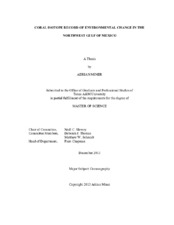| dc.description.abstract | Variations in the density banding and chemical composition of the skeletal material of long-lived corals in the Gulf of Mexico preserve records of past environmental conditions. To better interpret these records, the controlling mechanisms governing carbon and oxygen isotopes in coral skeletal material must be well understood. We have studied a Montastrea faveolata coral core from the Flower Garden Banks deposited over the 161 year period from 1844 to 2005. Annual growth bands revealed by X-radiography indicate the years and rates at which this material was deposited. We used a micro-milling device to obtain calcium carbonate samples at increments corresponding to approximately monthly resolution, and measured their stable oxygen (δ18O) and carbon isotope (δ13C) ratios with a mass spectrometer. The stable isotope records from this Montastrea faveolata coral reflect differences in the environmental controls of δ18O and δ13C fractionation. Annual variations of δ^(18)O coincide with density bands and reflect changes of seawater temperature, which in turn are linked to climate. Annual variations of δ^(13)C, which are largely controlled by photosynthesis, coincide with changes of insolation. Changes in the annual cycle of δ^(18)O lag those of δ^(13)C by about 2 months. We propose this difference exists because at the Flower Garden Banks the response of photosynthesis to seasonal changes in insolation occurs more rapidly than that of seawater temperature. Over the 161 year period of the record, the overall trend of δ^(13)C is toward more negative values and the annual range of δ^(13)C values increases. These patterns are consistent with the flux of fossil-fuel-derived carbon dioxide from the atmosphere to the ocean. Within the period of about 1900 to 1920, several years display particularly negative values. We speculate these values may result from Northern Hemisphere volcanism and/or interannual climate fluctuations. | en |


